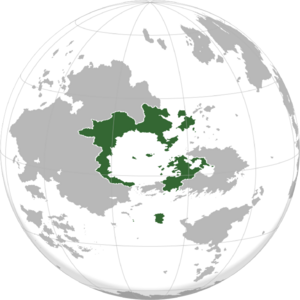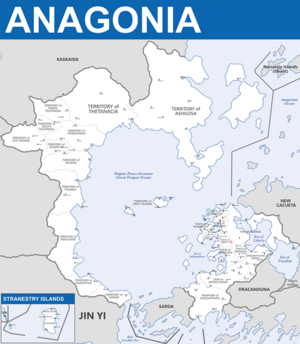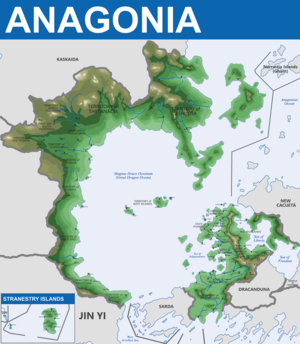Anagonia
This article is incomplete because it is pending further input from participants, or it is a work-in-progress by one author. Please comment on this article's talk page to share your input, comments and questions. Note: To contribute to this article, you may need to seek help from the author(s) of this page. |
The Confederate States of Anagonia Anagonia | |
|---|---|
| Motto: "Astra inclinant, sed nonobligant" (The stars incline, but do not oblige) | |
| Anthem: "My Country! 'Tis Of Thee" (Adopted July 14th, 104 AUR by Grand Congress vote) | |
 | |
| Capital | Liberty City |
| Largest city | Atlantica |
| Official languages | Native Anagonian & English |
| Recognised regional languages | Regional dialects dependent on State or Territory |
| Other languages | (Other European, Russian, Spanish, Other Asian, Various Non-Human Languages) |
| Ethnic groups (As of 108 AUR) | Anagonian (Primary) Various other ethnic groupings depending on state and territory |
| Demonym(s) | Anagonian(s), Confederate(s) |
| Government | Confederal Constitutional Presidential Republic |
• President | Mileethus Canisilus |
• Vice President | Franklin Johnson |
• Chief Secretary | Forest Patton |
• Chief General | Maximus Leddicus (Komodren; CSMC) |
• Chief Justice | Karl Roberts |
• Chief Admiral | Dave Evans (CSN) |
• Chief Senator | Wyatt Alexander |
• Grand Representative | Photios Nicoloulis (Kroman) |
| Legislature | Grand Congress of the Confederacy |
| Grand Senate of the Confederacy | |
| Grand House of Confederate Representatives | |
| Constitution & History Written: September 14th, 1921 CE Signed into Law: September 15th, 1921 CE | |
• Commonwealth of Mal-Videnus (1st iteration) | 110 BCE - 20 BCE |
• Republic of Anagonia | 23 CE - 24 CE |
• Commonwealth of Mal-Videnus (2nd iteration) | 24 CE - 925 CE |
• Kingdom of Anagonia | 1100 CE - 1360 CE |
• Free Republic of Anagonia | 1275 CE - 1361 CE |
• United Republic of Anagonia | 1361 CE - 1921 CE |
• Confederate States of Anagonia | 1921 CE - Present |
| Area | |
• Total | 21,864,400 km2 (8,441,900 sq mi) |
| Population | |
• 108 AUR estimate | 450,522,407 |
• Density | 5.77/km2 (14.9/sq mi) |
| GDP (nominal) | 108 AUR estimate |
• Total | D$28,424,257,741,025 |
• Per capita | D$78,246.01 |
| Gini | 0.43 low |
| HDI | 0.927 very high |
| Currency | Confederate DENAR (D$) |
| Time zone | UTC+5 (Anagonian Standard Time Zones) |
• Summer (DST) | UTC+6 (Anagonian Standard Time Zones) |
| Driving side | right |
| Calling code | 678 |
| Internet TLD | .CSA |
The Confederate States of Anagonia has:
| |
Introduction
Anagonia (pronounced An-a-goun-nia), officially the Confederate States of Anagonia, is a large nation that exists within the region of Esvanovia renowned for its rich cultural heritage, diverse landscapes, and vibrant biodiversity which includes non-human sapient life. Situated around the heart of the Anagonian Ocean and on two continential landmasses, Anagonia spans approximately 21,864,400 square kilometers, encompassing a primary territorial claim which surrounds the majestic Magnus Draco Oceanum, also known as the Great Dragon Ocean. The nation's territory is divided between the continents of Minor Kistavich, where the mainland is located, and Major Kistavich, which hosts the rest of the Territories across the Great Dragon Ocean.
Home to seven states—Lexington, Plymouth, Arkansis, Orgath, Liberty, Saratoga, and Imperius—and sixteen territories—West Islands, Wildlands, Ashilosa, Thetanacia, North Teustredia, South Teustredia, Thireatheria, Che Traman, Duderlia, Whiana, Thuaria, Arkleland, Hamotichia, Sarder, Wildlantaria, and the Stranestry Islands—Anagonia boasts a rich tapestry of cultural traditions and historical significance. Each state and territory contributes to the nation's unique identity, with distinct landmarks, festivals, and customs that reflect its heritage. Several non-human semi-sapient wildlife and non-human sapient citizens call these lands and territories home.
With its captivating scenery, fascinating wildlife and citizenry, and vibrant communities, Anagonia as a whole is a land of endless exploration and discovery which draws in visitors from far and wide to experience its wonders firsthand.
History
The history of Anagonia is a rich tapestry of cultural evolution, political transformation, and societal development. From its ancient origins to its modern-day status as a leading nation, Anagonia’s history is marked by significant events, influential leaders, and the enduring spirit of its people. The journey of Anagonia reflects its resilience, adaptability, and commitment to progress, shaping the nation into what it is today.
Etymology
The etymology of "Anagonia" intertwines with the ancient history and cultural tapestry of the land, reflecting the diverse influences that have shaped its meaning over time. At the heart of this etymology lies the intersection of two distinct cultures: the Seurians, akin to the Anglo-Saxons, and the indigenous Anagonians.
Historians, archeologists, and etymologists all agree that the native language of modern Anagonians and their unique name must derive from some experience with the Seurians prior to 6967 BCE.
Around 400 BCE, it was historically recorded both in ancient texts and archeological findings that Ancient Seuria, the ancient homeland of the Seurians on the continent of Major Kistavich, waged a violent war against the Anagonian people and her neighbors under the leadership of the Ancient Seurian known as "Oisean Macmathan". Rikor Hak, the well-known Second Disciple of Melkos, has well preserved journals and written texts on his and his armies experiences in fending off the "Seurian Empire".
It is through these journals, texts, and recorded historical events that etymologists have been able to conclude that Seuria played a heavy role in Anagonian language syntax and development. Seuria, which in modern day exists as a diminished island nation north of nations of Arcadie and Kaskaida and resides in the Northern Ocean, has had long-lasting cultural, linguistic, and other influences on Anagonian culture.
The supposed prefix "Ana-" and suffix "-gonia" further enrich the meaning of "Anagonia." The prefix "Ana-" could potentially denote a sense of primordial or native essence, suggesting an origin deeply rooted in the land itself. Meanwhile, the suffix "-gonia" commonly denotes a land or territory, implying that Anagonia is not just a place but a distinct realm imbued with its own unique character and significance. Together, these linguistic elements encapsulate the essence of Anagonia as a land of ancient heritage, mythical connections, and enduring legacy.
The name "Anagonia" carries echoes of both Seurian and Anagonian heritage. Through meticulous research and lore, it has been deciphered to translate as "Native Dragon Man," offering insight into the ancestral relationship between the Anagonians and the mythical dragons that roamed their land. This interpretation suggests a profound connection between the indigenous people and the awe-inspiring creatures that inhabited their midst. It also supposed that perhaps at one point, the word "Anagonia" could have used by Seurians as an identifier to what an Anagonian could have been before their name.
The term "Dragon Man" within the context of Anagonia evokes images of a society intertwined with the mythos of dragons, perhaps revered as guardians or spiritual beings. It speaks to a time when dragons may have played a significant role in the lives and legends of the Anagonian people, shaping their culture, beliefs, and even their very identity. Thus, "Anagonia" serves as a testament to the enduring bond between Anagonia and the mystical realm of dragons, a bond woven deep into the fabric of Anagonian history and lore, and a bond that persist to Modern Day as Anagonians continue pilgrimages to see their dragon kin.
Geography and Climate
Anagonia, a vast and diverse nation spanning approximately 21,864,400 square kilometers, boasts a varied landscape characterized by rugged mountains, sweeping plains, and coastal regions. With its mainland and capital situated southeast of the heart of the Anagonian Ocean, the nation itself encompasses and surrounds the magnificent Magnus Draco Oceanum, also known as the Great Dragon Ocean, which serves as the centerpiece of the nation's geography via its vast expanse.
Geography
Anagonia's mainland is delineated by the continents of Minor Kistavich and Major Kistavich, with the Great Dragon Ocean occupying the central expanse. The northern territories, including Ashilosa, Thetanacia, North Teustredia, South Teustredia, and Thireatheria, are dominated by mountainous terrain that gradually slopes downward into steppes, grasslands, and marshlands as they approach the Great Dragon Ocean. To the west, the Territories of Che Traman, Duderlia, Whiana, Thuaria, Arkleland, Hamotichia, and Sarder feature similar mountainous landscapes that give way to coastal plains along the shores of the Great Dragon Ocean.
In the western reaches of the nation lie the remnants of a sunken continent, now known as the West Islands, serving as a testament to ancient geological upheavals. The Stranestry Islands, located south of the Territory of Sarder in the West Arvolken Sea, offer a contrasting landscape with their gentle slopes and favorable weather conditions. To the east, mainland Anagonia transitions from the independent nation of Sarda to the Sovereign Nation of Nodea Rudav and the Imperial Drekamythian Empire, culminating in the peninsula-like mass of Anagonia proper.
The mainland of Anagonia, which is situated southeast of the Great Dragon Ocean on the continent of Minor Kistavich, is further divided into seven states: Lexington, Plymouth, Orgath, Liberty, Saratoga, Imperius, and Arkansis. The State of Saratoga and the State of Plymouth lay claim to three large islands in the Sea of Independence, providing strategic access to the Great Dragon Ocean.
Climate
Anagonia experiences a diverse range of climates due to its expansive geography and varied topography. The northern territories are characterized by a continental climate, with cold winters and warm summers, while the coastal regions benefit from milder temperatures moderated by oceanic influences.
In the mountainous regions, precipitation is abundant, resulting in lush forests and verdant valleys. The western territories receive ample rainfall, fostering fertile soils ideal for agriculture and supporting diverse ecosystems. In contrast, the eastern reaches of Anagonia, bordering the Imperial Drekamythian Empire and the Sovereign Nation of Nodea Rudav, experience somewhat drier conditions, with semi-arid climates prevailing in some areas. However this is diversified within the mainland of Anagonia in its primary states. They experiences a wide verity of temperate-to-dry conditions year-round which support a wide variety of agricultural and biological diversity, with mild winters typically thanks to warmer currents flowing from the north.
The coastal regions, including the Territories of Che Traman, Duderlia, Whiana, Thuaria, Arkleland, Hamotchia, and Sarder, enjoy mostly temperate climates characterized by mild winters and moderate summers. The Stranestry Islands boast favorable weather conditions year-round, making them popular destinations for tourists and travelers seeking relaxation and tranquility.
Overall, Anagonia's climate and geography contribute to its rich biodiversity and cultural diversity, making it a land of endless exploration and discovery.
Biodiversity
Anagonia is home to a diverse range of ecosystems, supporting a wide variety of flora and fauna. The country's unique geographical features, including its forests, mountains, rivers, and coastal regions, contribute to its rich biodiversity. Conservation efforts are in place to protect the natural habitats and ensure the preservation of the nation's ecological heritage for future generations.
Government
Executive Branch
The Executive Branch of the Confederate States of Anagonia is responsible for enforcing federal laws and administering the various government functions across the nation. Headed by the President, the Executive Branch includes both the Senior and Junior Cabinets, which manage essential and specialized departments respectively. It plays a pivotal role in the day-to-day governance of the Confederacy, ensuring the implementation of policies and the coordination of national efforts across a wide range of areas, from defense and foreign relations to domestic affairs and infrastructure.
Legislative Branch
The Legislative Branch of the Confederate States of Anagonia is led by the Grand Congress of the Confederacy. The Grand Congress is a Joint Governing Body established to encourage participation among individual states and territories and provide an avenue and forum to debate the future of the Confederacy. The Grand Congress of the Confederacy also handles Colonial Affairs via an independent body which is comprised of elected representatives, one from each member-state.
Judicial Branch
The Judicial Branch of the Confederate States of Anagonia is the highest authority on legal and constitutional matters within the nation. Established alongside the founding of the Confederacy in 1921 CE, the Judicial Branch, led by the Supreme Court of the Confederacy, ensures the rule of law, interprets the Constitution, and resolves disputes among states and territories. It operates independently, upholding justice and protecting individual rights across the Confederacy. The court system, rooted in English common law and tailored to each state's unique legal framework, serves as a cornerstone of Anagonian governance, maintaining balance and integrity within the legal system.
Law
The Articles of the Armed Forces of the Confederacy and the Constitution of the Confederate States of Anagonia are foundational to the governance and protection of Anagonia. Ratified in 1921 CE, these documents emphasize the importance of sovereignty, freedom, and the rule of law. The Articles of the Armed Forces define the military's role in safeguarding the nation, including its authority to veto policies threatening national interests. The Constitution outlines the powers of the executive, legislative, and judicial branches, ensuring checks and balances while protecting individual rights. Together, they uphold democratic principles, individual liberties, and the continuity of Anagonian civilization.
Constitution
The Constitution of the Confederate States of Anagonia is the foundational legal document that outlines the structure, powers, and responsibilities of the government. Ratified on September 15th, 0 AUR (1921 CE), it enshrines the principles of sovereignty, democracy, and individual freedoms, serving as the ultimate guide for governance and law in the nation. The Constitution establishes the framework for the executive, legislative, and judicial branches, ensuring a balance of power and the protection of citizens' rights.
Military Articles
The Military Articles of Anagonia are a set of laws that define the role, responsibilities, and authority of the Confederate States Armed Forces. These articles emphasize the military's commitment to protecting the nation's sovereignty, ensuring the rights and will of the people, and safeguarding national security. The Military Articles also establish the framework for military-government relations, including the authority of the military to veto policies that may threaten the nation's continuity or security.
Diplomacy
Diplomatic relations in the Confederate States of Anagonia are managed by the Confederate States Diplomatic Corps (CSDC), a specialized branch of the government composed primarily of skilled military personnel who have been thoroughly vetted and trained for diplomatic roles. The CSDC actively serves as ambassadors and liaisons in foreign affairs. Established in 3 AUR (1924 CE), the CSDC operates under the Department of the Confederate States and is responsible for representing Anagonia in both national and international diplomatic arenas. The Corps emphasizes the principles of professionalism, proficiency, patience, and perseverance, ensuring that its members are fully prepared to handle complex diplomatic tasks with the highest level of competence.
Alliances & Organizations
Law Enforcement
The primary Law Enforcement in the Confederate States of Anagonia is provided by the Confederate States Military Police (CSMP), which serves as both the National Guard and the primary civil protection agency. The CSMP is responsible for maintaining law and order across the nation, including enforcing regulations, responding to civil unrest, and ensuring public safety. Their unique military-based training emphasizes the defense of the people, fostering professionalism and respect within the communities they serve.
Military
The Armed Forces of Anagonia are a robust and integral part of the nation’s defense and sovereignty. Comprising various branches, including the Army, Navy, Air Force, Marine Corps, and Military Police, the military plays a crucial role in both national security and international peacekeeping efforts. The Armed Forces are guided by the principles outlined in the Military Articles of Anagonia, ensuring their commitment to the protection of the nation and its citizens.
Space Program
The Space Program of Anagonia is a key element of the nation’s technological and scientific advancement. Managed by the Confederate Aeronautics and Space Administration (CASA), the program focuses on space exploration, satellite deployment, and international cooperation in space missions. The space program symbolizes Anagonia's commitment to innovation and leadership in space technology.
Economy
Anagonia boasts a diverse and dynamic economy, supported by various sectors including agriculture, industry, technology, and services. The nation's economic policies are designed to promote sustainable growth, international trade, and the well-being of its citizens. The economy is characterized by a mix of state and private enterprises, with a strong emphasis on innovation and competitiveness in the global market.
Culture
Architecture
Visual Art
Cuisine
Media
Demographics
Population
Cities
Religion
Religion in Anagonia is deeply intertwined with the nation's cultural identity and history. The predominant belief system, known as Drekanity, reflects the spiritual and philosophical values of the Anagonian people. This faith, centered around reverence for dragons and the concepts of life and mortality, plays a significant role in shaping the societal norms, rituals, and moral compass of Anagonia. The main deity, Melkos Unchanos, is a death-like entity. However, instead of being a figure to dread, Anagonians who worship him view him as the master of life, death, afterlife, and reincarnation.




